|
Review
AMD Athlon™ 64 4000+ and FX-55 Review
by John
Reynolds
Introduction
 AMD
is announcing today two new processors to their Athlon 64
series of CPUs, the Athlon 64 4000+ and the Athlon 64 FX-55.
Both processors are 939-pin, micro-PGA parts and are manufactured
at AMD’s Dresden, Germany, fabrication plant using a
130nm SOI process. The FX-55, with its 2.6 GHz clock speed,
is a speed stepping of 200 Mhz above the FX-53 and its 2.4
GHz frequency, with both parts sharing the same amount of
cache, 128 KB (64 data + 64 instruction) of L1 and 1 MB of
L2 cache. The Athlon 64 4000+, however, has an identical clock
speed to that of the 3800+ reviewed earlier this summer, which
is a core frequency of 2.4 GHz. Interestingly enough, the
4000+’s L2 cache has been doubled in size to 1 MB to
match that of the FX chips. The chart below shows the different
specifications of the CPUs that will be tested in this review. AMD
is announcing today two new processors to their Athlon 64
series of CPUs, the Athlon 64 4000+ and the Athlon 64 FX-55.
Both processors are 939-pin, micro-PGA parts and are manufactured
at AMD’s Dresden, Germany, fabrication plant using a
130nm SOI process. The FX-55, with its 2.6 GHz clock speed,
is a speed stepping of 200 Mhz above the FX-53 and its 2.4
GHz frequency, with both parts sharing the same amount of
cache, 128 KB (64 data + 64 instruction) of L1 and 1 MB of
L2 cache. The Athlon 64 4000+, however, has an identical clock
speed to that of the 3800+ reviewed earlier this summer, which
is a core frequency of 2.4 GHz. Interestingly enough, the
4000+’s L2 cache has been doubled in size to 1 MB to
match that of the FX chips. The chart below shows the different
specifications of the CPUs that will be tested in this review.
| |
3800+
|
4000+
|
FX-55
|
| Transistor count |
68m
|
105.9m
|
105.9m
|
| L1 Cache |
128 KB
|
128 KB
|
128 KB
|
| L2 Cache |
512 KB
|
1 MB
|
1 MB
|
| Clock Speed |
2.4 GHz
|
2.4 GHz
|
2.6 GHz
|
It is somewhat surprising to see
AMD increasing the L2 cache of the Athlon 64 4000+ rather
than its frequency because of the increase in transistors
this has added to the processor. Increased die size translates
into fewer chips per wafer for the manufacturing process being
used, which obviously means fewer processors to sell to OEMs
or the retail market. AMD’s roadmap still lists a 90nm
Athlon 64 core, code named Winchester, due the second half
of this year, so once available we should see clock speed
increases in addition to the 1 MB L2 cache as the cores are
migrated to the new process. The move of the Athlon 64 FX
processors to 90nm is not expected, however, until early next
year. Until then, the 4000+ is a cache rather than clock speed
increase over the 3800+.
In addition to the integrated memory
controller and its 6.4 GB of bandwidth the Athlon 64s boast,
AMD is also continuing to heavily market EVP (Enhanced Virus
Protection) and C’n’Q (Cool‘n’Quiet).
Also known as NX (no execute), EVP is hardware support designed
to prevent the running of code that attempts to execute in
a memory area marked as a data page, which is a common tool
used by many malware authors. To enable EVP requires Windows
XP with Service Pack 2 to be installed. C’n’Q works
by monitoring system usage (CPU cycles) and dynamically adjusting
the processor’s frequency and voltage down to reduce
heat during periods of lessened workload. Noise is also reduced
using an on-die thermistor to detect lower temperatures, at
which point the fan speed on the processor is slowed. Once
the temperature rises the fan will resume its full speed.
Care was taken during testing to ensure that C’n’Q
was disabled to avoid inaccurate performance scores.
The Athlon 64 4000+ and FX-55’s
initial pricing are slightly higher than that of AMD’s
earlier releases, priced in bulk at $729 and $827 respectively.
In comparison, the 3800+ was initially priced at $720 and
the FX-53 $799.
The
AMD Athlon™ 64 Processor
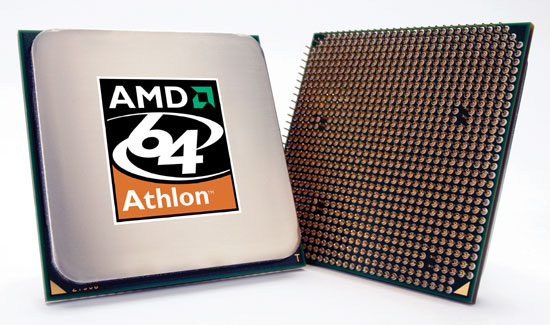
The
AMD Athlon™ 64 FX Processor
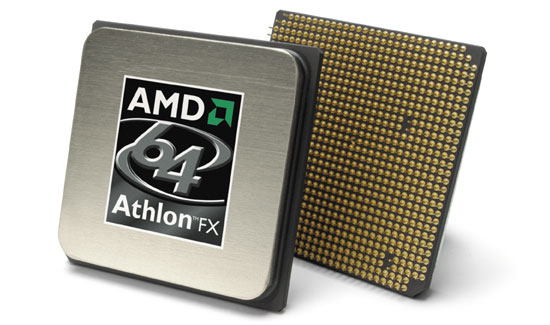
Go
To Page 2
AMD Athlon™ 64 4000+ and FX-55 Review
Back
to Page 1
Test System Setup
- AMD Athlon 64 3800+, 4000+, and
FX-55 processors
- MSI K8N Neo2 motherboard (nForce
5.10)
- 1 GB (2 x 512 MB) Corsair XMS PC3200
DDR RAM
- VisionTek 9800 Pro 128 MB (Catalyst
4.9 drivers)
- Adaptec 19160 SCSI controller
- 36 GB Seagate Cheetah 15,000 RPM
HD (NTFS)
- Windows XP Professional - Service
Pack 2
- DirectX 9.0c
The benchmark suite used to test the
Athlon 64 3800+, 4000+, and FX-55 is listed here.
All games are configured for 32-bit color and trilinear texture
filtering as the baseline default. Anti-aliasing and anisotropic
texture filtering are, of course, disabled throughout all
tests. Windows XP is also configured to have Automatic Update,
System Restore, and all unnecessary startup services disabled.
Fraps v2.3.2 was used to record performance scores unless
otherwise noted. However, because a faster AGP graphics board
was not available for use in the test system, in-game options
for each title were changed to lower, less demanding graphics
settings to keep the 9800 Pro from becoming a performance
bottleneck and thus preventing the tested processors from
differentiating themselves. Once PCI Express chipsets for
AMD systems become available here in the near future, this
will no longer be an issue since SimHQ’s ‘hardware
lab’ has several high-end PCIe graphics boards available
for testing.
Scores for the Athlon 64 3800+ in
this review are not comparable to those from SimHQ’s
original review
of the CPU because, as mentioned above, testing was conducted
with lower in-game settings, updated Catalyst drivers from
ATI were used, and a different motherboard, MSI’s K8N
Neo2, which is based on NVIDIA’s nForce 3 Ultra chipset,
was installed in the test system; the 3800+ review’s
test system used ASUS’ A8V Deluxe mainboard, based on
VIA’s K8T800 Pro chipset.
Benchmark Scores
The Comanche
4 benchmarking demo was run with texture compression
enabled and hardware shaders and sound disabled.
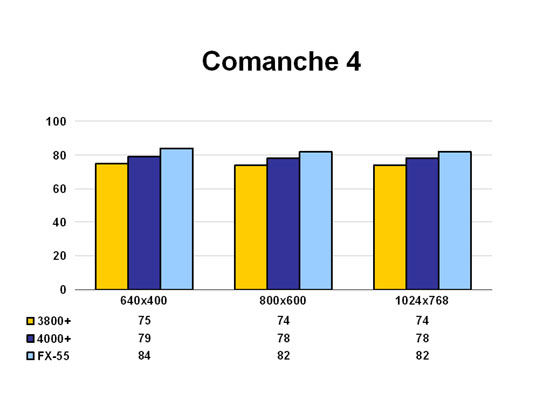
A piece of software that has traditionally
scaled very closely with CPU speed, the C4 demo displays a
consistent performance increase for each resolution and processor.
In fact, the FX-55 is the first CPU to break the 80+ frame
rate barrier in SimHQ’s testing.
Lock
On: Modern Air Combat was tested using the first three
minutes of the MiG-29 Intercept demo. The in-game graphics
default setting of low was applied in the hopes of keeping
the 9800 Pro card from becoming a performance choke-point
in the test system.
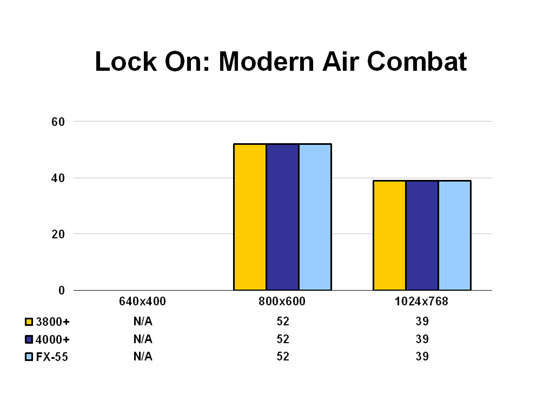
Without a doubt the graphics card
is refusing to allow LOMAC to scale with processor changes.
Next is Microsoft’s
Flight Simulator 2004, the ruling king of civilian
aviation simulation. Testing consisted again of SimHQ’s
dusk flight over the city of Hong Kong, with an external camera
view positioned behind the aircraft. The game’s display
settings were placed at medium low and all box options were
unchecked.

Unfortunately, in the effort to prevent
the slower graphics card from bottlenecking the test systems,
FS2004 appears to have capped itself at 100 fps. The in-game
frame rate option was set to Unlimited and the display's refresh
rate was not set at 100 Hz. Further experimentation with in-game
graphics settings, such as placing each sub-section at high,
still saw the frame rate pegged at 100; in fact, not until
the hardware options were placed at near-maximum settings
did the frame rate begin to drop.
FS2004 also scales fairly well with
faster processors once the graphics settings are dialed down
a few notches as noted above. The game appears to benefit
more from the FX-55’s higher frequency than the 4000+’s
increased L2 cache, showing at 800x600 a 12 frame improvement
for the FX-55 over the 4000+ compared to the latter’s
8 fps gain over the 3800+. This pattern also continues at
1024x768.
Go
To Page 3
AMD Athlon™ 64 4000+ and FX-55 Review
Back
to Page 2
IL-2:
Sturmovik Forgotten Battles - Aces Expansion Pack was
tested in OpenGL and with all video options set to medium
(normal for Objects detail) using the Black Death track.
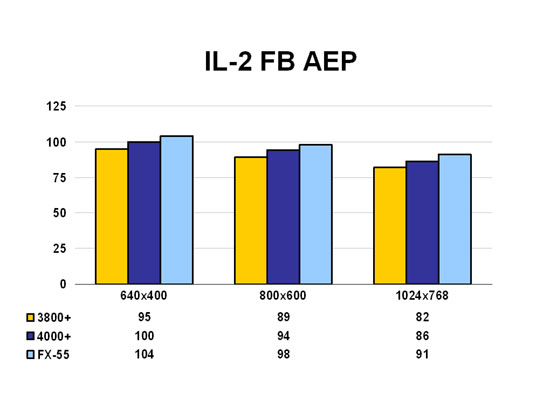
For each processor change, IL-2 shows
roughly a 5% performance gain for the tested resolutions,
with AMD’s latest CPUs hitting a 3-digit frame rate at
640x480.
Falcon
4 performance testing again used the FreeFalcon
3 upgrade mode with SimHQ’s in-house test of a low
level, air-to-ground flight that consists of two Falcons using
Mk20s and Mavericks. Graphics options, however, were left
at their highest settings since the title can hardly be considered
as stressful to the test rig’s graphics sub-system.

With the FF3 mode installed, F4 essentially
refuses to scale for both resolution change and for the 4000+.
For the FX-55’s faster core frequency, however, the game
showed a surprising 15% frame rate improvement at 640x480,
and settled into roughly 8% for the higher resolutions.
Far
Cry is undoubtedly the most graphically advanced title
in SimHQ’s benchmark suite. As such, all in-game advanced
video options were set at medium. Testing consisted of repeated
run-throughs of the Research map in God mode since the level
includes an excellent combination of the beach, jungle, and
interior settings found throughout the game.
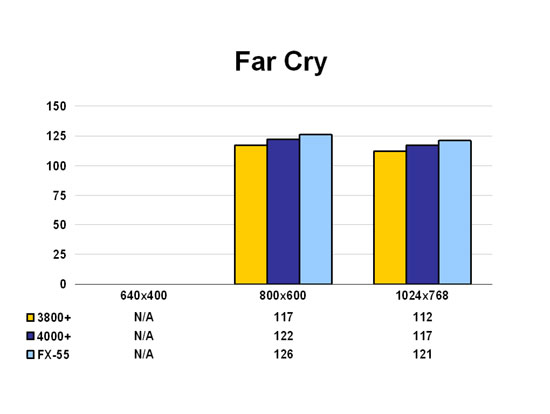
Far Cry displays a performance delta
between the tested CPUs of roughly 3-4%, indicating that even
with medium graphics settings the title’s frame rate
is still possibly limited by the test system’s 9800 Pro,
though the scores are certainly much higher compared to when
higher in-game settings are enabled.
Developed using id Software’s
five-year-old Quake 3 engine, Call
of Duty (v1.4) is the second title SimHQ uses testing
OpenGL rather than the D3D API. Because the game is based
on such an aged engine, graphics settings were left unchanged.
Scores were derived from the Dawnville demo using the in-game
timedemo utility to capture performance. The “com_maxfps”
console command was also used to lift the default frame rate
cap of 85.
As usual, Call of Duty scales extremely
well with hardware changes. Worth noting is the game appears
to benefit more from the FX-55’s clock speed compared
to the 4000+’s larger cache.
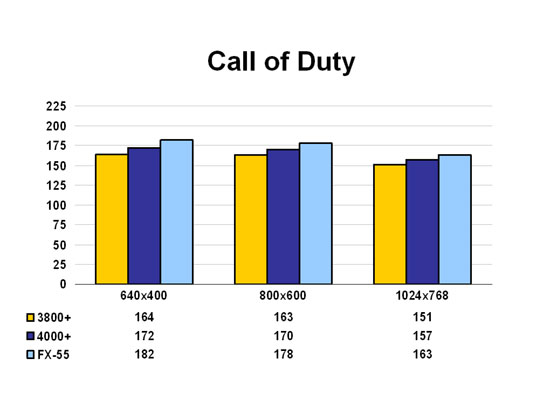
Go
To Page 4
AMD Athlon™ 64 4000+ and FX-55 Review
Back
to Page 3
Last is NASCAR
Racing 2003 Season, tested using a crowded Daytona
track and a camera view set inside of Earnhardt’s cockpit.
Graphics settings were also configured to medium options and
shadows disabled.
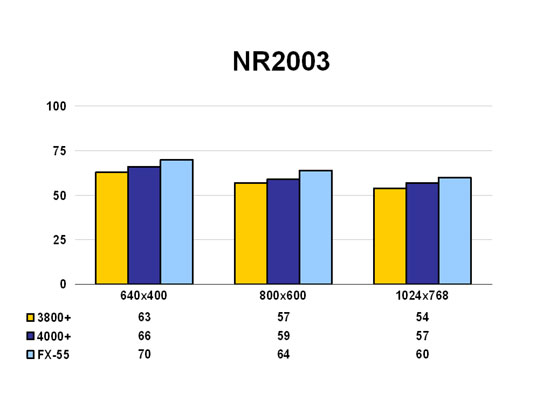
At the two lower resolutions, the
FX-55 shows more improvement over the 4000+ than the latter
does over the 3800+, though the difference in gains is marginal
at 640x480. Like most other titles not bottlenecked by the
graphics card, NASCAR displays close to 5% difference between
CPUs.
Gallery
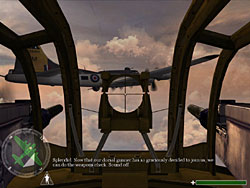 |
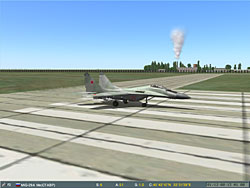 |
IL-2: Sturmovik - Forgotten Battles
- AEP
(250 kb jpg) |
Lock On: Enemy Air Combat
(2.25MB bmp) |
Conclusion
SimHQ’s benchmark suite displayed
a fairly uniform 5% performance gain across the board for
AMD’s new processors over their slower parts, with the
FX-55’s clock speed increase allowing the CPU to scale
itself slightly better than the 4000+. The Athlon 64 family
of processors has proven that they can dominate in a 32-bit
gaming environment, though the performance they offer is certainly
not as inexpensive as past Athlons have been alongside comparable
Intel parts. It will be interesting to see if the migration
to the 90nm process and its smaller die sizes will have any
impact on Athlon 64 pricing; and with Winchester still due
this year and San Diego (the 90nm FX core) sometime next,
it will also be interesting to see if AMD releases any additional
130nm processors before moving the entire Athlon 64 family
to the new process. And of even more excitement to hardware
enthusiasts, there is of course the expectations for dual-core
processors that both AMD and Intel are currently striving
to bring first to the market late next year.
The MSI K8N Neo2, using the nForce
3 Ultra chipset, proved itself to be as stable as the A8V
Deluxe motherboard used earlier this year. Though the unfortunate
inclusion of a 9800 Pro in the test system clearly held the
Athlon 64 4000+ and FX-55 from reaching higher performance
levels in several of the simulations tested, the two processors
only strengthen AMD’s performance lead over the competition.
And with their release, the new CPUs should help trickle the
pricing on previously introduced Athlon 64s down. Yet for
the simulation gaming fan who feels compelled to build the
absolute fastest rig available today, they need look no further
than the Athlon 64 FX-55.
Download a pdf of this
article here
(x kb).
The "How SimHQ
Tests" page is here.
The page includes our test criteria and links to the new Benchmark
Suite.
Click
here to go to top of this page.
Copyright 2008, SimHQ.com. All Rights Reserved. Contact the webmaster.
|

